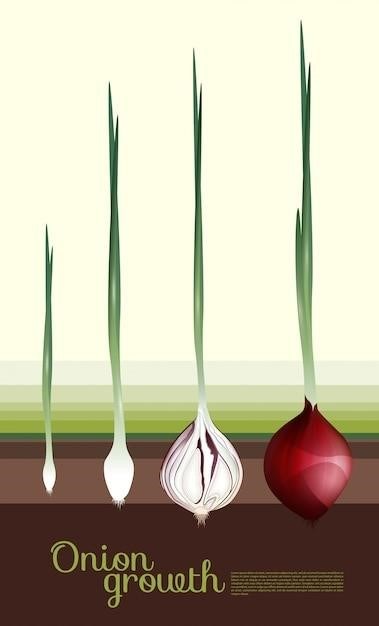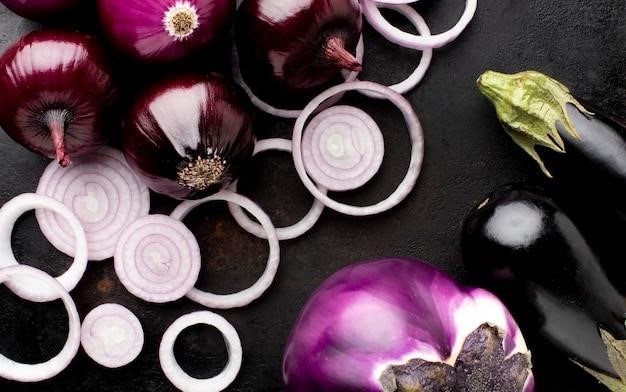The Onion Guide⁚ Everything You Need to Know
This guide will be your one-stop shop for all things onion. From selecting the perfect onion for your needs to growing your own, we’ll cover everything you need to know about this versatile vegetable. Whether you’re a seasoned chef or a novice gardener, we’ve got you covered!
Introduction
The humble onion is a culinary staple around the world, adding flavor and depth to countless dishes. But beyond its culinary uses, the onion has a fascinating story to tell. From its ancient origins to its diverse varieties and unique growing habits, the world of onions is surprisingly rich and complex. This guide aims to demystify the onion, offering insights into its history, cultivation, and culinary applications.
Whether you’re a seasoned gardener seeking to cultivate your own onion patch or a home cook looking to enhance your culinary repertoire, this guide will equip you with the knowledge and skills necessary to navigate the fascinating world of onions.
Join us as we delve into the secrets of the onion, exploring its history, cultivation techniques, and diverse uses in cooking, from caramelizing to adding a pungent bite to your favorite dishes. Get ready to unlock the potential of this versatile vegetable and discover a world of flavor waiting to be explored.
Choosing the Right Onion
The world of onions is surprisingly diverse, with a range of varieties offering distinct flavors and textures. Knowing which type to choose can make all the difference in your cooking. For example, a sweet Vidalia onion is ideal for caramelizing, while a pungent red onion adds a sharp bite to salsas and salads.
When selecting onions, consider the intended use. For a milder flavor, opt for white or yellow onions. Red onions, known for their bolder flavor and vibrant color, are often used in salads and salsas. Sweet onions, like Vidalia and Walla Walla, are perfect for caramelizing and adding a touch of sweetness to dishes;
Beyond flavor, consider storage life. Some onions, like storage onions, can be kept for months in a cool, dry place, while others, like spring onions, are best used fresh. Finally, look for onions with firm texture, dry skins, and no signs of sprouting or discoloration. These simple tips will help you choose the perfect onion for your culinary needs.
Growing Onions
Growing your own onions can be a rewarding experience, providing a fresh supply of this versatile ingredient throughout the season. Onions thrive in sunny locations with well-drained soil, making them a relatively easy crop to cultivate. They require a minimum of 6 hours of direct sunlight per day, and a soil pH between 6.0 and 6.8 is ideal.
Before planting, prepare the soil by incorporating plenty of compost or well-rotted manure. This will improve drainage and provide essential nutrients for healthy growth. Onions can be grown in raised beds or directly in the ground, but ensuring proper drainage is crucial.
There are three main methods for planting onions⁚ direct sowing, using onion sets, and transplanting seedlings. Direct sowing is the most common method, while onion sets offer a faster harvest, and transplants provide a head start for late-season plantings.
Soil and Location
Choosing the right location and soil type is crucial for successful onion cultivation. Onions prefer a sunny spot that receives at least six hours of direct sunlight daily. They thrive in well-drained soil, meaning soil that allows water to pass through it readily, preventing waterlogging.
Heavy clay soils can be challenging for onions, as they tend to retain water. To improve drainage in such soils, consider growing onions in raised beds or raised rows. These mounds of soil provide better aeration and allow excess water to drain away.
Before planting, enrich the soil with compost or well-rotted manure. This will improve soil structure, drainage, and provide essential nutrients for healthy growth. A soil pH between 6.0 and 6.8 is ideal for onions. You can test your soil pH using a kit available at most garden centers.
Planting Methods
There are three primary methods for planting onions, each with its own advantages⁚ direct sowing, onion sets, and transplants. Direct sowing involves planting onion seeds directly into the garden bed. This method is ideal for those who want to start their onions from scratch and enjoy a longer growing season.
Onion sets are small, pre-grown onions that can be planted directly into the ground. They are a popular choice for gardeners seeking a quicker harvest and are known for their high success rate. Transplants are young onion seedlings that have been grown in containers. They provide a head start for your onions and are particularly useful in areas with short growing seasons.
No matter which method you choose, ensure the soil is prepared properly and the onions are planted at the correct depth. Regular watering and weeding will help your onions thrive.
Direct Sowing
Direct sowing is the most traditional method for planting onions. It involves planting onion seeds directly into the garden bed, giving you complete control over the process and allowing you to choose the exact variety you desire. The ideal time for direct sowing depends on your location and climate, but generally occurs in the spring or early summer.
To ensure optimal germination, the soil temperature should be between 50°F and 75°F. Sow the seeds 1/8 to 1/2 inch deep, spacing them 2 to 4 inches apart. After planting, water the seeds thoroughly and maintain consistent moisture levels. Thin the seedlings when they reach a few inches tall, leaving the strongest plants spaced 4 to 6 inches apart.
Direct sowing requires patience, as onion seeds can take a few weeks to germinate. However, it offers the satisfaction of nurturing your onions from seed to harvest.
Onion Sets
Onion sets are a popular choice for gardeners seeking a quicker and more convenient way to grow onions. These pre-grown bulbs, resembling tiny onions, are available at garden centers and online retailers. They offer a faster harvest than seeds, typically maturing in about 14 weeks.
Planting onion sets is a straightforward process. Space them 10 to 15 centimeters apart, with 30 centimeters between rows. Plant them just below the soil surface, ensuring the tips are visible. Choose moisture-retentive, fertile soil, ideally enriched with well-rotted organic matter such as garden compost.
Onion sets are known for their resilience, capable of withstanding light freezes. They also boast a higher success rate compared to direct-sown seeds or transplants, making them a reliable option for beginner gardeners.
Transplants
Transplanting onion seedlings is a method that allows for a head start in the growing process, especially when starting from seeds. This technique involves nurturing seedlings indoors or in a protected environment until they reach a certain size before transferring them to the garden bed.
To start onion transplants, sow seeds indoors or in a seed tray about 6 to 8 weeks before the last frost date. Once the seedlings have developed their first true leaves, they are ready for transplanting. Choose a sunny location in your garden with well-drained soil. Space the seedlings 6 inches apart in rows that are 12 inches apart.
When transplanting, handle the seedlings gently to avoid damaging their delicate roots. Water them regularly, especially during dry periods, and keep the soil consistently moist. With proper care, your onion transplants will thrive and yield a bountiful harvest;
Care and Maintenance
Once your onions are planted, they need consistent care to thrive. Regular watering is crucial, especially during dry spells. Aim for deep, infrequent watering, allowing the soil to dry out slightly between waterings. Avoid overwatering, as this can lead to root rot.
Weeding is another essential part of onion care. Keep your onion beds free of weeds, which compete for nutrients and moisture. You can hand-pull weeds or use a hoe to control them.
Fertilizing onions is also important, especially if your soil is poor in nutrients. Apply a balanced fertilizer, such as a 10-10-10 formula, a few weeks after planting. You can also use compost or manure as a natural fertilizer.
Finally, keep an eye out for pests and diseases. Common onion pests include onion flies and thrips. To prevent pests, consider using row covers or companion planting. If you see any signs of disease, treat it promptly to prevent it from spreading.
Harvesting and Storing Onions
The time to harvest onions is when the tops have fallen over and the bulb feels firm to the touch. You can gently pull on the top of the onion to see if it comes out easily. If it does, it’s ready to harvest.
Once you’ve harvested your onions, it’s important to cure them properly. This process dries out the bulbs and prevents them from rotting. Curing involves drying the onions in a warm, dry place for a few weeks. You can lay the onions out in a single layer on a screen or in a dry, airy room.
After curing, you can store your onions in a cool, dry place. A well-ventilated pantry or basement is ideal. Avoid storing onions in humid or warm environments. Proper storage can help your onions last for several months.
When storing onions, it’s important to separate them from other vegetables. Some vegetables, such as potatoes, release ethylene gas, which can cause onions to sprout.
Types of Onions
The world of onions is surprisingly diverse, with a variety of colors, sizes, and flavors to choose from. Here are some of the most common types of onions⁚
- Yellow Onions⁚ These are the most common type of onion, with a strong, pungent flavor. They are often used in savory dishes, such as soups, stews, and stir-fries.
- Red Onions⁚ Red onions have a milder flavor than yellow onions and a slightly sweet taste. They are often used in salads, salsas, and other dishes where their vibrant color adds a visual appeal.
- White Onions⁚ White onions have a sharp, pungent flavor and are commonly used in Mexican and Asian cuisine. They are often grilled or caramelized.
- Sweet Onions⁚ Sweet onions have a milder, sweeter flavor and are often used in salads, sandwiches, and other dishes where their sweetness enhances the flavors.
- Shallots⁚ Shallots are small, elongated onions with a delicate, sweet flavor. They are often used in sauces, soups, and other dishes where their subtle flavor adds depth and complexity.
Using Onions in Cooking
Onions are a culinary staple, adding flavor, texture, and depth to countless dishes. From savory stews and soups to vibrant salads and salsas, onions are a versatile ingredient that can elevate any meal. Here are some tips for using onions in your cooking⁚
- Caramelize⁚ Caramelizing onions is a classic technique that transforms their flavor into a rich, sweet, and savory delight. Simply cook chopped onions over low heat until they are soft and brown, adding a touch of sugar or balsamic vinegar for extra depth. Caramelized onions are a delicious addition to burgers, pizzas, and sandwiches.
- Sauté⁚ Sautéing onions is a quick and easy way to bring out their natural flavors. Simply cook chopped onions in a bit of oil or butter until they are soft and translucent. Sautéed onions are a versatile base for many dishes, such as stir-fries, pasta sauces, and omelets.
- Roast⁚ Roasting onions brings out their natural sweetness and creates a tender, caramelized texture. Simply roast whole onions or wedges in the oven until they are soft and slightly browned. Roasted onions are delicious served as a side dish or added to salads and soups.
Caramelizing Onions
Caramelized onions are a culinary staple, adding a touch of sweetness and depth to countless dishes. The process involves slowly cooking chopped onions over low heat until they soften and develop a rich, brown color. This transformation not only enhances their flavor but also creates a delightful, caramelized texture. Here’s a breakdown of the process⁚
- Choose the Right Onion⁚ While any onion can be caramelized, yellow onions are generally preferred due to their balance of sweetness and sharpness. Avoid using red onions, as their strong flavor can overpower the caramelized notes.
- Slice Thinly⁚ Thinly slicing onions ensures even cooking and prevents burning. You can use a sharp knife or a mandoline for precise slices.
- Cook Slowly⁚ Patience is key when caramelizing onions. Cook them over low heat, stirring frequently, to allow them to soften and brown gradually. The process can take anywhere from 30 to 45 minutes.
- Add Fat and Flavor⁚ Use a neutral oil, such as vegetable or canola oil, to prevent the onions from sticking. You can also add a small amount of butter or a splash of balsamic vinegar for additional depth of flavor.
Cutting Onions
Cutting onions can be a tear-inducing experience, but with the right technique, you can minimize the sting. Here’s how to slice an onion like a pro⁚
- Prep Your Onion⁚ Start by trimming the root end and the top of the onion. This will help stabilize the onion while you cut it.
- Cut in Half⁚ Cut the onion in half lengthwise, through the root end. This will make it easier to slice the onion into thin rings or wedges.
- Slice or Dice⁚ For thin slices, hold the onion half with the cut side facing up and slice across the onion from root to tip. For diced onions, cut the onion half into quarters, then slice each quarter into thin strips before chopping them into cubes.
- Avoid Tears⁚ Cutting onions releases tear-inducing compounds called syn-propanethial-S-oxide. To minimize tears, try chilling the onion for 30 minutes before cutting, cutting under running water, or wearing a pair of safety goggles. You can also try cutting the onion near a vent to help disperse the vapors.
Onion Network
The term “onion network” usually refers to the Tor network, a system designed to enhance privacy and security online. The name comes from the layered structure of encryption used to protect user data. Imagine an onion with multiple layers; each layer represents a different level of encryption. When you use the Tor network, your data is wrapped in these layers of encryption as it travels through a series of “onion routers.” Each router peels off a layer of encryption, revealing the next destination for your data. This process ensures that your data is highly protected and makes it difficult to track or intercept. The Tor network is particularly useful for people who need to protect their identity and communication, such as journalists, activists, and those living under oppressive regimes.
Onion Model
The onion model is a visual representation of hierarchical systems, often used in organizational management and communication. It’s a simple yet powerful tool for understanding complex structures and relationships. The model uses the image of an onion to illustrate the layers of information, complexity, and influence within an organization. Just like an onion, the model has multiple layers, each representing a different level of the hierarchy. The outer layer represents the most visible aspects of the organization, such as its public image and mission statement. As you move inward, you encounter deeper layers that reveal the underlying interests, motivations, and power dynamics within the organization. The core of the onion represents the most fundamental values, beliefs, and goals that drive the organization. The onion model helps to visualize how different elements within an organization are interconnected and how they contribute to its overall function. This model can be applied to various contexts, including business management, social networks, and even personal relationships. By understanding the different layers of an onion model, you can gain valuable insights into the complexities of any given system.


